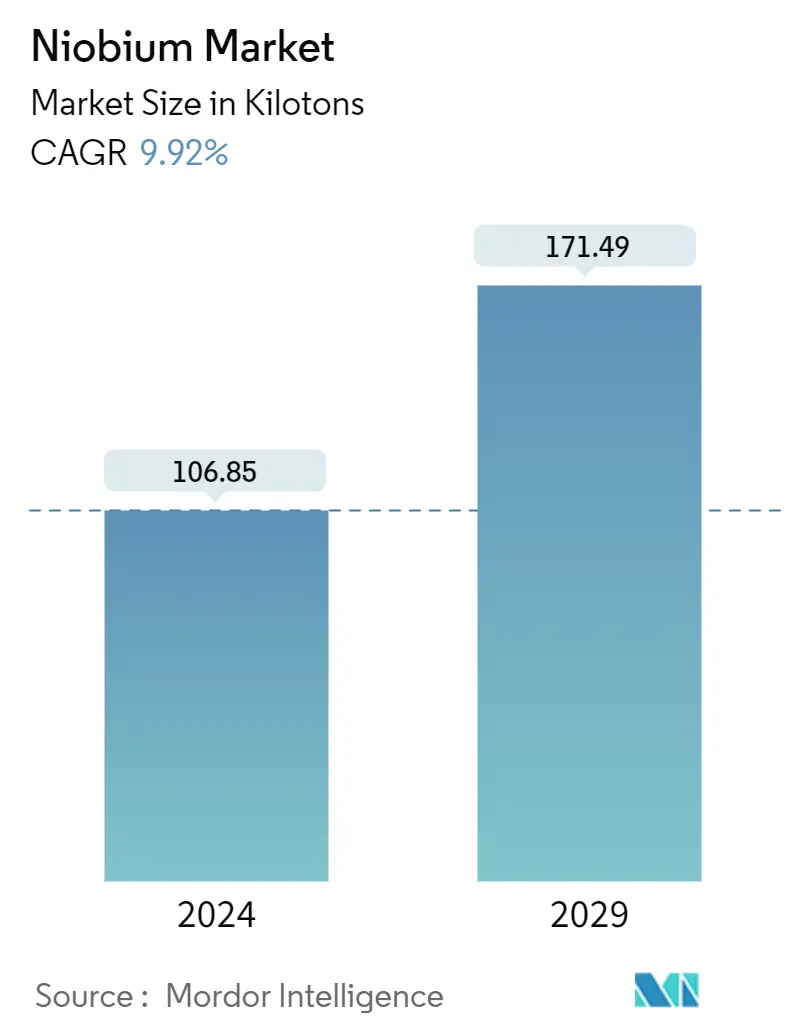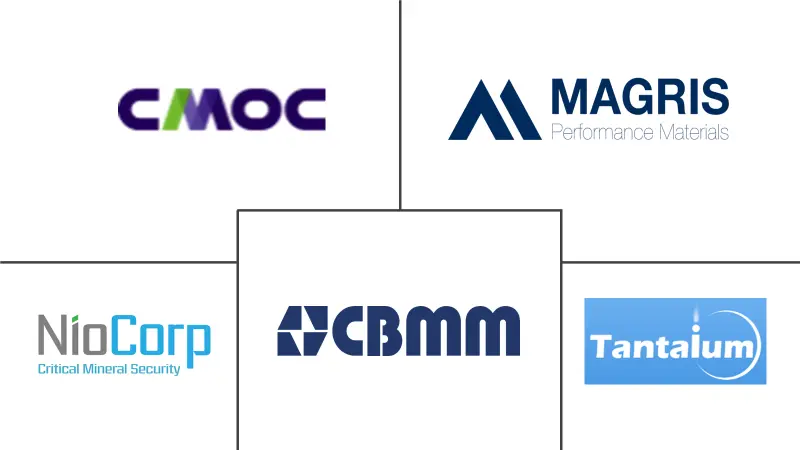Market Size of Niobium Industry

| Study Period | 2019-2029 |
| Market Volume (2024) | 106.85 kilotons |
| Market Volume (2029) | 171.49 kilotons |
| CAGR (2024 - 2029) | 9.92 % |
| Fastest Growing Market | Asia Pacific |
| Largest Market | Asia Pacific |
| Market Concentration | High |
Major Players
*Disclaimer: Major Players sorted in no particular order |
Niobium Market Analysis
The Niobium Market size is estimated at 106.85 kilotons in 2024, and is expected to reach 171.49 kilotons by 2029, growing at a CAGR of 9.92% during the forecast period (2024-2029).
The COVID-19 pandemic negatively impacted the market in 2020. This was because of the shutdown of the manufacturing facilities and plants due to the lockdown and restrictions. Supply chain and transportation disruptions further created hindrances for the market. However, the industry witnessed a recovery in 2021, thus rebounding the demand for the market studied.
- Over the medium term, accelerating usage of structural steel and increasing demand for lighter-weight and more fuel-efficient vehicles are some of the factors driving the growth of the market studied.
- On the flip side, limited supply sources and concerns about health issues on acute exposure is expected to hinder the growth of the market.
- However, the expected usage of niobium in next-generation lithium-ion batteries and innovative techniques and mine design are anticipated to provide numerous opportunities over the forecast period.
- Asia-Pacific dominated the market with the largest consumption from countries, such as China and Japan.
Niobium Industry Segmentation
Niobium is a rare, soft, malleable, ductile, gray-white metal. Niobium is primarily used in alloys, including stainless steel. It improves the strength of the alloys, particularly at low temperatures. At present, it is gaining momentum in lithium-ion battery production.
The niobium market is segmented based on occurrence, type, application, end-user industry, and geography. By occurrence, the market is segmented into carbonatites and associates and columbite-tantalite. By type, the market is segmented into ferroniobium, niobium oxide, niobium metal, and vacuum grade niobium alloys. By application, the market is segmented by steel, superalloys, superconducting magnets and capacitors, batteries, and other applications. By end-user industry, the market is segmented by construction, automotive and shipbuilding, aerospace and defense, oil and gas, and other end-user industries. The report offers market size and forecasts for 15 countries across major regions. For each segment, market sizing and forecasts have been done on the basis of volume (tons) for all the above segments.
| Occurrence | |
| Carbonatites and Associates | |
| Columbite-Tantalite |
| Type | |
| Ferroniobium | |
| Niobium Oxide | |
| Niobium Metal | |
| Vacuum-Grade Niobium Alloys |
| Application | |
| Steel | |
| Super Alloys | |
| Superconducting Magnets and Capacitors | |
| Batteries | |
| Other Applications |
| End-user Industry | |
| Construction | |
| Automotive and Shipbuilding | |
| Aerospace and Defense | |
| Oil and Gas | |
| Other End-user Industries |
| Geography | |||||||
| |||||||
| |||||||
| |||||||
| |||||||
|
Niobium Market Size Summary
The niobium market is poised for significant growth over the forecast period, driven by its increasing application in structural steel and the automotive industry, particularly in Asia-Pacific regions like China, India, and Japan. The construction sector remains the largest consumer of niobium, utilizing it in high-strength micro-alloyed plate products for infrastructure projects such as bridges and high-rise buildings. The demand for niobium is further bolstered by its use in high-strength and wear-resistant materials for railway tracks and its role in enhancing the properties of steel reinforcing bars. Despite challenges such as limited supply sources and health concerns related to acute exposure, the market is expected to benefit from innovations in lithium-ion battery technology and mine design, offering new opportunities for growth.
The market landscape is characterized by a consolidated structure with key players like CBMM, CMOC, and NioCorp Development Ltd. These companies are actively expanding their capacities and exploring new applications for niobium, such as in electric vehicles and clean energy solutions. The Asia-Pacific region, particularly China, is a major driver of demand due to its robust steel production and growing automotive sector. The region's construction industry, supported by government initiatives and investments, is also a significant contributor to niobium consumption. As global construction activities rebound and the demand for high-strength low alloys increases, the niobium market is expected to experience steady growth, with Asia-Pacific continuing to dominate in terms of consumption and production.
Niobium Market Size - Table of Contents
-
1. MARKET DYNAMICS
-
1.1 Drivers
-
1.1.1 Accelerating Usage in Structural Steel
-
1.1.2 Growing Demand for Lighter-Weight and More Fuel-Efficient Vehicles
-
-
1.2 Restraints
-
1.2.1 Limited Supply Sources
-
1.2.2 Concerns About Health Issues on Acute Exposure
-
-
1.3 Industry Value Chain Analysis
-
1.4 Porter's Five Forces Analysis
-
1.4.1 Bargaining Power of Suppliers
-
1.4.2 Bargaining Power of Buyers
-
1.4.3 Threat of New Entrants
-
1.4.4 Threat of Substitute Products and Services
-
1.4.5 Degree of Competition
-
-
1.5 Technological Snapshot/ Production Analysis
-
1.6 Price Trends
-
-
2. MARKET SEGMENTATION (Market Size in Volume)
-
2.1 Occurrence
-
2.1.1 Carbonatites and Associates
-
2.1.2 Columbite-Tantalite
-
-
2.2 Type
-
2.2.1 Ferroniobium
-
2.2.2 Niobium Oxide
-
2.2.3 Niobium Metal
-
2.2.4 Vacuum-Grade Niobium Alloys
-
-
2.3 Application
-
2.3.1 Steel
-
2.3.2 Super Alloys
-
2.3.3 Superconducting Magnets and Capacitors
-
2.3.4 Batteries
-
2.3.5 Other Applications
-
-
2.4 End-user Industry
-
2.4.1 Construction
-
2.4.2 Automotive and Shipbuilding
-
2.4.3 Aerospace and Defense
-
2.4.4 Oil and Gas
-
2.4.5 Other End-user Industries
-
-
2.5 Geography
-
2.5.1 Asia-Pacific
-
2.5.1.1 China
-
2.5.1.2 India
-
2.5.1.3 Japan
-
2.5.1.4 South Korea
-
2.5.1.5 Rest of Asia-Pacific
-
-
2.5.2 North America
-
2.5.2.1 United States
-
2.5.2.2 Canada
-
2.5.2.3 Mexico
-
-
2.5.3 Europe
-
2.5.3.1 Germany
-
2.5.3.2 United Kingdom
-
2.5.3.3 Russia
-
2.5.3.4 Italy
-
2.5.3.5 Rest of Europe
-
-
2.5.4 South America
-
2.5.4.1 Brazil
-
2.5.4.2 Argentina
-
2.5.4.3 Rest of South America
-
-
2.5.5 Middle-East and Africa
-
2.5.5.1 Saudi Arabia
-
2.5.5.2 South Africa
-
2.5.5.3 Rest of Middle-East and Africa
-
-
-
Niobium Market Size FAQs
How big is the Niobium Market?
The Niobium Market size is expected to reach 106.85 kilotons in 2024 and grow at a CAGR of 9.92% to reach 171.49 kilotons by 2029.
What is the current Niobium Market size?
In 2024, the Niobium Market size is expected to reach 106.85 kilotons.

